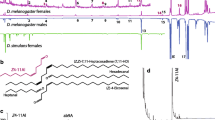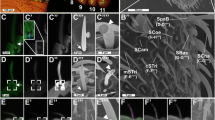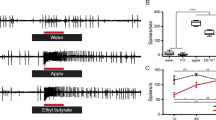Abstract
The olfactory circuitry of Drosophila melanogaster is becoming increasingly clear. However, how olfactory processing translates into appropriate behavioral responses is still poorly understood. Using a sibling species approach, we tested how a perturbation in the olfactory circuitry affects odor preference. In a previous study, we found that the sibling species of D. melanogaster, the specialist D. sechellia, overrepresents a sensillum, ab3, the A neuron of which is sensitive to hexanoate esters, characteristic of the species’ sole host, the Morinda citrifolia fruit. Concordantly, the corresponding glomerulus, DM2, is enlarged. In this study, we found that the ab3B neuron, the expansion of which was previously assumed to be pleiotropic and of no ecological significance, is in fact tuned to another morinda fruit volatile, 2-heptanone (HP). Axons of this neuron type arborize in a second enlarged glomerulus. In behavioral experiments we tested how this has affected the fly’s odor preference. We demonstrate that D. sechellia has a reversed preference for the key ligands of these macroglomeruli, especially at high concentrations. Whereas D. melanogaster was repelled by high concentrations of these odors, D. sechellia was highly attracted. This was the case for odors presented singly, but more notably for blends thereof. Our study indicates that relatively simple changes, such as a shift in sensillar abundance, and concordant shifts in glomerular size, can distort the resulting olfactory code, and can lead to saltatory shifts in odor preference. D. sechellia has exploited this to align its olfactory preference with its ecological niche.



Similar content being viewed by others
References
Acebes A, Ferrus A (2001) Increasing the number of synapses modifies olfactory perception in Drosophila. J Neurosci 21:6264–6273
Amlou M, Moreteau B, David JR (1998) Genetic analysis of Drosophila sechellia specialization: oviposition behavior toward the major aliphatic acids of its host plant. Behav Genet 28(6):455–464
Arnold G, Masson C, Budharugsa S (1985) Comparative study of the antennal lobes and their afferent pathway in the workerbee and the drone Apis mellifera. Cell Tissue Res 242:593–605
Asahina K, Louis M, Piccinotti S, Vosshall LB (2009) A circuit supporting concentration-invariant odor perception in Drosophila. J Biol 8:9
Ayyub C, Paranjape J, Rodrigues V, Siddiqi O (1990) Genetics of olfactory behavior in Drosophila melanogaster. J Neurogen 6:243–262
Boeckh J, Ernst KD (1987) Contribution of single unit analysis in insects to an understanding of olfactory function. J Comp Physiol A 161:549–565
Christensen TA, Hildebrand JG (1987) Functions, organization, and physiology of the olfactory pathways in the lepidopteran brain. In Gupta AP (ed) Arthropod brain. Its evolution, development, structure and functions. pp 457–484
Christensen TA, Waldrop BR, Harrow ID, Hildebrand JG (1993) Local interneurons and information processing in the olfactory glomeruli of the moth Manduca sexta. J Comp Physiol A 173:385–399
Couto A, Alenius M, Dickson BJ (2005) Molecular, anatomical, and functional organization of the Drosophila olfactory system. Curr Biol 15:1535–1547
de Bruyne M, Clyne PJ, Carlson JR (1999) Odor coding in a model olfactory organ: the Drosophila maxillary palp. J Neurosci 19:4520–4532
de Bruyne M, Smart R, Zammit E, Warr C (2010) Functional and molecular evolution of olfactory neurons and receptors for aliphatic esters across the Drosophila genus. J Comp Physiol A 196:97–109
Dekker T, Steib B, Carde RT, Geier M (2002) l-Lactic acid: a human-signifying host cue for the anthropophilic mosquito Anopheles gambiae. Med Vet Entomol 16:91–98
Dekker T, Ibba I, Siju KP, Stensmyr M, Hansson BS (2006) Olfactory shifts parallel superspecialism for toxic fruit in Drosophila melanogaster sibling, D. sechellia. Curr Biol 16:101–109
Farine JP, Legal L, Moreteau B, LeQuere JL (1996) Volatile components of ripe fruits of Morinda citrifolia and their effects on Drosophila. Phytochemistry 41:433–438
Galizia CG, Joerges J, Kuttner A, Faber T, Menzel R (1997) A semi-in-vivo preparation for optical recording of the insect brain. J Neurosci Methods 76:61–69
Hallem EA, Carlson JR (2006) Coding of odors by a receptor repertoire. Cell 125:143–160
Hansson BS, Ljungberg H, Hallberg E, Lofstedt C (1992) Functional specialization of olfactory glomeruli in a moth. Science 256:1313–1315
Hansson B, Knaden M, Sachse S, Stensmyr MC, Whicher D (2009) Toward plant-odor related olfactory neuroethology in Drosophila. Chemoecology 20:51–61
Hartlieb E, Anton S, Hansson BS (1997) Dose-dependent response characteristics of antennal lobe neurons in the male moth Agrotis segetum (Lepidoptera: Noctuidae). J Comp Physiol A 181:469–476
Hildebrand J, Matsumoto SG, Camazine SM, Tolbert LP, Blank S, Ferguson H, Ecker V (1980) Organisation and physiology of antennal centres in the brain of the moth Manduca sexta. In Insect Neurobiology and Pesticide Action. Soc. Chem., London
Hill SR, Zaspel J, Weller S, Hansson BS, Ignell R (2010) To be or not to be... a vampire: a matter of sensillum numbers in Calyptra thalictri? Arthropod Struct Dev 39:322–333
Jones CD (1998) The genetic basis of Drosophila sechellia’s resistance to a host plant toxin. Genetics 149:1899–1908
Karpati Z, Olsson S, Hansson B (2010) Dekker T (2010) Inheritance of central neuroanatomy and physiology related to pheromone preference in the male European corn borer. BMC Evol Biol 10:286
Kliman RM, Andolfatto P, Coyne JA, Depaulis F, Kreitman M, Berry AJ, McCarter J, Wakeley J, Hey J (2000) The population genetics of the origin and divergence of the Drosophila simulans complex species. Genetics 156:1913–1931
Kreher SA, Mathew D, Kim J, Carlson JR (2008) Translation of sensory input into behavioral output via an olfactory system. Neuron 59:110–124
Lachaise D, Cariou ML, David JR, Lemeunier F, Tsacas L, Ashburner M (1988) Historical biogeography of the Drosophila-melanogaster species subgroup. Evol Biol 22:159–225
Lachaise D, Harry M, Solignac M, Lemeunier F, Benassi V, Cariou ML (2000) Evolutionary novelties in islands: Drosophila santomea, a new melanogaster sister species from Sao Tome. Proc R Soc Lond Ser B Biol Sci 267(1452):1487–1495
Laissue PP, Reiter C, Hiesinger PR, Halter S, Fischbach KF, Stocker RF (1999) Three-dimensional reconstruction of the antennal lobe in Drosophila melanogaster. J Comp Neurol 405:543–552
Lemeunier F, David JR, Tsacas L, Ashburner M (1986) The melanogaster species subgroup. In: Ashburner M, Carson HL, Thompson JN Jr (eds) The genetics and biology of Drosophila, Vol. 3e. Xix+548p. Academic Press Inc., Orlando, Fla. USA, pp. 147–256
Masse NY, Turner GC, Jefferis G (2009) Olfactory information processing in Drosophila. Curr Biol 19(16):R700–R713
Matsuo T, Sugaya S, Yasukawa J, Aigaki T, Fuyama Y (2007) Odorant-binding proteins OBP57d and OBP57e affect taste perception and host-plant preference in Drosophila sechellia. Plos Biol 5:985–996
McBride CS (2007) Rapid evolution of smell and taste receptor genes during host specialization in Drosophila sechellia. Proc Natl Acad Sci USA 104:4996–5001
McBride CS, Arguello JR (2007) Five Drosophila genomes reveal nonneutral evolution and the signature of host specialization in the chemoreceptor superfamily. Genetics 177:1395–1416
McIver S, Hudson A (1972) Sensilla on antennae and palps of selected Wyeomya mosquitoes. J Med Entomol 9:337
Ray A, van Naters WV, Carlson JR (2008) A regulatory code for neuron-specific odor receptor expression. PLoS Biol 6:1069–1083
Riffell JA, Lei H, Christensen TA, Hildebrand JG (2009) Characterization and coding of behaviorally significant odor mixtures. Curr Biol 19:335–340
R’Kha S, Capy P, David JR (1991) Host-plant specialization in the Drosophila melanogaster species complex: a physiological, behavioral, and genetical analysis. Proc Natl Acad Sci USA 88:1835–1839
Rospars JP (1988) Structure and development of the insects antennodeutocerebral system. Int J Insect Morphol Embryol 17:243–294
Sachse S, Galizia CG (2003) The coding of odour-intensity in the honeybee antennal lobe: local computation optimizes odour representation. Eur J Neurosci 18:2119–2132
Semmelhack JL, Wang JW (2009) Select Drosophila glomeruli mediate innate olfactory attraction and aversion. Nature 459:218–U100
Smadja C, Butlin RK (2009) On the scent of speciation: the chemosensory system and its role in premating isolation. Heredity 102:77–97
Steib BM, Geier M, Boeckh J (2001) The effect of lactic acid on odour-related host preference of yellow fever mosquitoes. Chem Sens 26:523–528
Stensmyr MC, Dekker T, Hansson BS (2003) Evolution of the olfactory code in the Drosophila melanogaster subgroup. Proc R Soc Lond B 270:2333–2340
Sucena E, Stern DL (2000) Divergence of larval morphology between Drosophila sechellia and its sibling species caused by cis-regulatory evolution of ovo/shaven-baby. Proc Natl Acad Sci USA 97:4530–4534
Tasin M, Backman AC, Bengtsson M, Varela N, Ioriatti C, Witzgall P (2006) Wind tunnel attraction of grapevine moth females, Lobesia botrana, to natural and artificial grape odour. Chemoecology 16:87–92
Touhara K, Vosshall LB (2009) Sensing odorants and pheromones with chemosensory receptors. Annu Rev Physiol 71:307–332
Wang JW, Wong AM, Flores J, Vosshall LB, Axel R (2003) Two-photon calcium imaging reveals an odor-evoked map of activity in the fly brain. Cell 112:271–282
Wilson RI, Turner GC, Laurent G (2004) Transformation of olfactory representations in the Drosophila antennal lobe. Science 303:366–370
Zhang QH, Schlyter F (2003) Redundancy, synergism, and active inhibitory range of non-host volatiles in reducing pheromone attraction in European spruce bark beetle Ips typographus. Oikos 101:299–310
Acknowledgements
The authors thank G. Stemmler of the GoodNoni company Fiji Islands for shipments of morinda fruit. The study was funded through the Linnaeus grant, ICE3, to the division of Chemical Ecology, Alnarp Sweden, FORMAS grant 2007–1491 to TD, and by MIUR, International Interuniversity Cooperation to AMA.
Authors’ contributions
I. Ibba performed the experiments, analysed the data and drafted the manuscript. T. Dekker conceived the concept of the study and contributed to interpretation of data and writing the manuscript. A.M. Angioy and B. Hansson were involved in interpretation of data and writing of the manuscript. All authors have read and approved the final version of the manuscript.
Author information
Authors and Affiliations
Corresponding author
Rights and permissions
About this article
Cite this article
Ibba, I., Angioy, A.M., Hansson, B.S. et al. Macroglomeruli for fruit odors change blend preference in Drosophila . Naturwissenschaften 97, 1059–1066 (2010). https://doi.org/10.1007/s00114-010-0727-2
Received:
Revised:
Accepted:
Published:
Issue Date:
DOI: https://doi.org/10.1007/s00114-010-0727-2




